Though some farmers are finding success growing coffee in the microclimate of Southern California, American labor costs and limited production keep California-grown coffee at a price point that most Americans simply cannot afford.
Despite that, the United States is the largest coffee-consuming nation in the world. And an enormous amount of work happens after the coffee leaves the farm: importing across oceans, processing and grading, transporting to roasters, roasting to bring out flavor, packaging, and finally preparing, brewing, selling and serving it to millions of people every day. Coffee farming might start in the tropics, but the coffee industry inside U.S. borders is massive.
For decades, coffee entered the country duty-free, a recognition of its foundational role in a U.S. industry that supports more than 1.7 million American jobs. That exemption is now gone. In April, the Trump administration implemented a 10 percent baseline tariff on nearly all imported coffee. This month, it raised tariffs on dozens of trading partners, with coffee-producing nations India, Indonesia and Vietnam facing sharply higher rates. Coffee from countries with strong trade agreements with the U.S., including Mexico and Colombia, remains exempt, for the most part. Yet Brazil, the world’s largest producer of coffee, was slapped last week with a 50 percent tariff. Brazil provides about 30 percent of the coffee consumed in the United States, so this will massively impact both coffee prices and the industry within U.S. borders.
